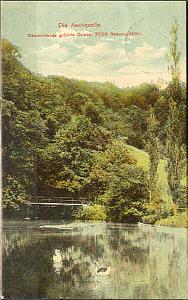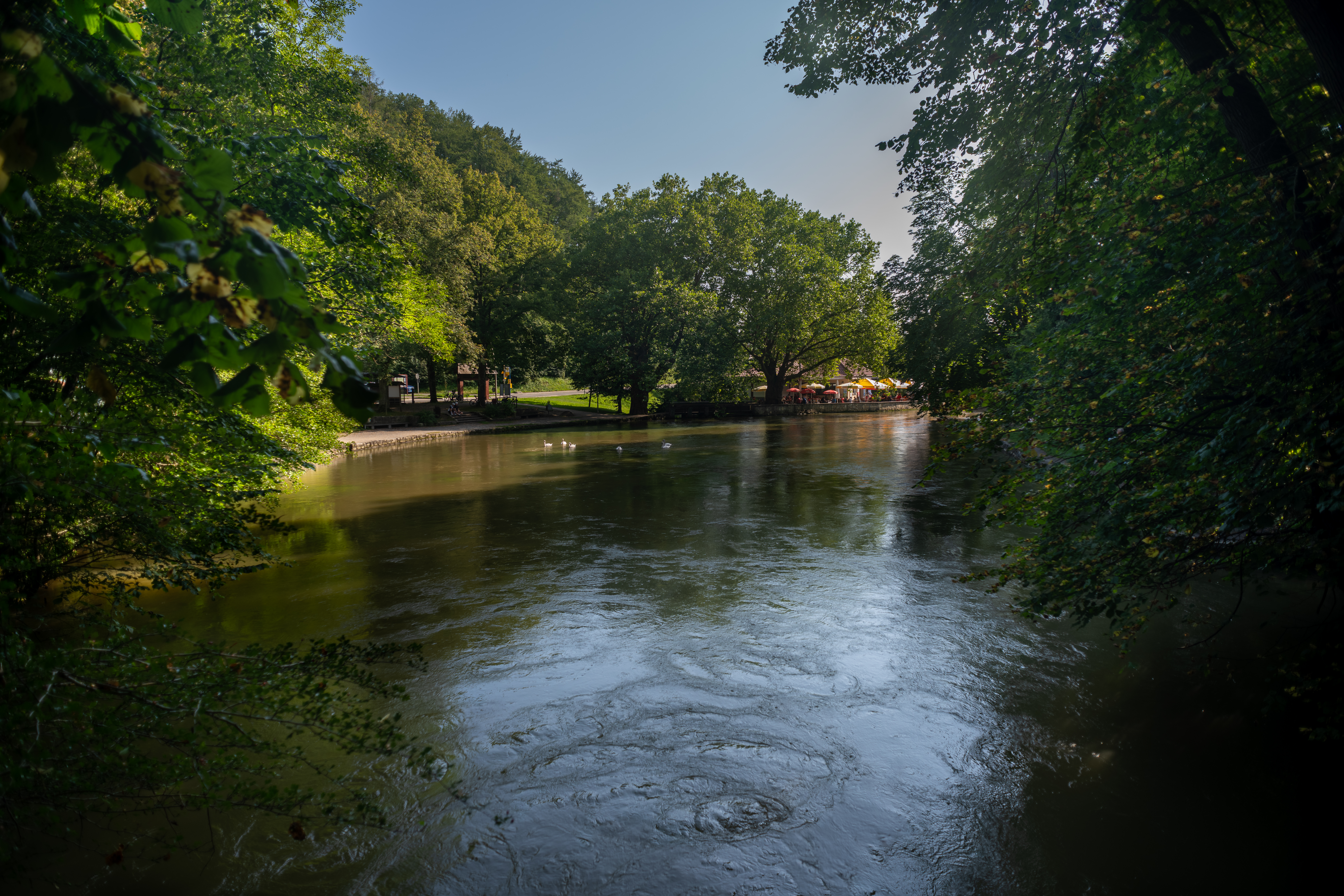Aachtopf on:
[Wikipedia]
[Google]
[Amazon]
 The Aachtopf () is
The Aachtopf () is


Aachtopf
showcaves.com. * 15 min * 6 min * {{coord, 47, 50, 48, N, 8, 51, 29, E, region:DE-BW_type:waterbody , display=title 43 min Springs of Germany Karst springs Karst formations of Germany Landforms of Baden-Württemberg Caves of Germany SAachtopf SAachtopf Geography of Hegau
 The Aachtopf () is
The Aachtopf () is Germany
Germany,, officially the Federal Republic of Germany, is a country in Central Europe. It is the second most populous country in Europe after Russia, and the most populous member state of the European Union. Germany is situated betwee ...
's biggest karst spring
A karst spring or karstic spring is a spring (outflow of groundwater) that is part of a karst hydrological system.
Description
Because of their often conical or inverted bowl shape, karst springs are also known in German-speaking lands as a ''To ...
, south of the western end of the Swabian Jura
The Swabian Jura (german: Schwäbische Alb , more rarely ), sometimes also named Swabian Alps in English, is a mountain range in Baden-Württemberg, Germany, extending from southwest to northeast and in width. It is named after the region of ...
near the town of Aach. It produces an average of 8,500 litres per second. Most of the water stems from the River Danube where it disappears underground at the Danube Sinkhole, north near Immendingen and about north near Fridingen
Fridingen () is a town in the district of Tuttlingen, in Baden-Württemberg, Germany. It is situated on the Danube, 10 km east of Tuttlingen, and 23 km west of Sigmaringen. A large hoard of Bronze Age jewellery (mostly armlets and bra ...
. The cave system has been explored since the 1960s, but as of 2020 only a small part has been discovered due to a large blockage after a few hundred metres.
Etymology
The name Aachtopf is compounded from ''Aach'' (meaning "water" inOld High German
Old High German (OHG; german: Althochdeutsch (Ahd.)) is the earliest stage of the German language, conventionally covering the period from around 750 to 1050.
There is no standardised or supra-regional form of German at this period, and Old Hig ...
); ''Topf'' can be translated as "bowl" and is commonly used for round, bowl-shaped springs.

Geography
The Aachtopf is akarst spring
A karst spring or karstic spring is a spring (outflow of groundwater) that is part of a karst hydrological system.
Description
Because of their often conical or inverted bowl shape, karst springs are also known in German-speaking lands as a ''To ...
, south of the western end of the Swabian Jura
The Swabian Jura (german: Schwäbische Alb , more rarely ), sometimes also named Swabian Alps in English, is a mountain range in Baden-Württemberg, Germany, extending from southwest to northeast and in width. It is named after the region of ...
near the town of Aach. The spring is the source of the river Radolfzeller Aach, which flows southward into Lake Constance
Lake Constance (german: Bodensee, ) refers to three bodies of water on the Rhine at the northern foot of the Alps: Upper Lake Constance (''Obersee''), Lower Lake Constance (''Untersee''), and a connecting stretch of the Rhine, called the Lak ...
, and empties into the Rhine
), Surselva, Graubünden, Switzerland
, source1_coordinates=
, source1_elevation =
, source2 = Rein Posteriur/Hinterrhein
, source2_location = Paradies Glacier, Graubünden, Switzerland
, source2_coordinates=
, source ...
.
Origin
The spring marks the southern end of a cave system that transports water from the western end of the Swabian Jura. It produces an average of 8,500 litres per second. Production varies seasonally and in response to the weather, but the spring never runs dry. Most of the water is derived from theDanube
The Danube ( ; ) is a river that was once a long-standing frontier of the Roman Empire and today connects 10 European countries, running through their territories or being a border. Originating in Germany, the Danube flows southeast for , pa ...
where it disappears underground at the ''Donauversickerung'' ( Danube Sinkhole) near Immendingen and Fridingen
Fridingen () is a town in the district of Tuttlingen, in Baden-Württemberg, Germany. It is situated on the Danube, 10 km east of Tuttlingen, and 23 km west of Sigmaringen. A large hoard of Bronze Age jewellery (mostly armlets and bra ...
. The Rhine's steeper gradient on its much shorter route to the North Sea creates stronger headward erosion than that of the much older River Danube (see the Danube upper river geology). This stream capture
Stream capture, river capture, river piracy or stream piracy is a geomorphological phenomenon occurring when a stream or river drainage system or watershed is diverted from its own bed, and flows instead down the bed of a neighbouring stream. T ...
of the upper Danube and its surface tributaries is expected to cause the long-term disappearance of the Danube drainage entirely in favour of the Rhine.
The Danube flows eastwards into the Black Sea
The Black Sea is a marginal mediterranean sea of the Atlantic Ocean lying between Europe and Asia, east of the Balkans, south of the East European Plain, west of the Caucasus, and north of Anatolia. It is bounded by Bulgaria, Georgia, Rom ...
, whereas the Rhine flows northwards to the North Sea
The North Sea lies between Great Britain, Norway, Denmark, Germany, the Netherlands and Belgium. An epeiric sea on the European continental shelf, it connects to the Atlantic Ocean through the English Channel in the south and the Norwegian ...
. Therefore, the water of the Aach flows under the European watershed. This is a relatively common feature of karst stream captures.
The karst spring is connected to a huge cave, which runs northwards. The cave is completely water-filled and can only be explored by cave diver
Cave-diving is underwater diving in water-filled caves. It may be done as an extreme sport, a way of exploring flooded caves for scientific investigation, or for the search for and recovery of divers or, as in the 2018 Thai cave rescue, other ...
s.
History of exploration
In 1719, F. W. Bräuninger published his hypothesis that the water of the spring originated from the Danube. On 9 October 1877, the geologistAdolf Knop
Adolf Knop (12 January 1828, in Altenau – 27 December 1893, in Karlsruhe) was a German geologist and mineralogist.
He studied mathematics and sciences at the University of Göttingen, where he was a pupil of chemist Friedrich Wohler and m ...
from Karlsruhe Technical College laced the water in the Danube basin with 10 kg sodium fluorescein, 20 zentner (1000 kg) of salt and 1200 kg of shale oil
Shale oil is an unconventional oil produced from oil shale rock fragments by pyrolysis, hydrogenation, or thermal dissolution. These processes convert the organic matter within the rock ( kerogen) into synthetic oil and gas. The resulting ...
. After 60 hours he was able to detect all three substances in the spring, as evidenced by "splendidly green, salt water with a distinct creosote taste".
In 1886, the first attempt to dive down the Aachtopf (and one of the world’s first cave dives) was made, to , at the location of a bottleneck where the water has a strong flow.
In 1960, the first exploration of the cave was made by Jochen Hasenmayer, a famous German cave diver. from the spring the syphon
A siphon (from grc, σίφων, síphōn, "pipe, tube", also spelled nonetymologically syphon) is any of a wide variety of devices that involve the flow of liquids through tubes. In a narrower sense, the word refers particularly to a tube in a ...
opens into a cavern, the "Seenhalle" (Lake Hall). A collapse blocks the cave after . The cave is expected to continue for several kilometres on the other side of the blockage.
In 1990, a local caving club was formed to find the lost cave segment towards the Danube basin by digging a shaft behind the collapse at the bottom of a large sink hole. In 1995, members discovered a cavern at deep, which they dubbed the Grey Hall, and in 2003 another cavern with a lake, which Rudi Martin has described in a report. The group has published maps of the "Donauhöhle".
As of 2020, exploration is ongoing and the continuation of the cave has not been discovered.
Fauna
In 2015, the only known cavefish in Europe, a '' Barbatula'' loach, was discovered in the Danube–Aachtopf system.
References
External links
Aachtopf
showcaves.com. * 15 min * 6 min * {{coord, 47, 50, 48, N, 8, 51, 29, E, region:DE-BW_type:waterbody , display=title 43 min Springs of Germany Karst springs Karst formations of Germany Landforms of Baden-Württemberg Caves of Germany SAachtopf SAachtopf Geography of Hegau